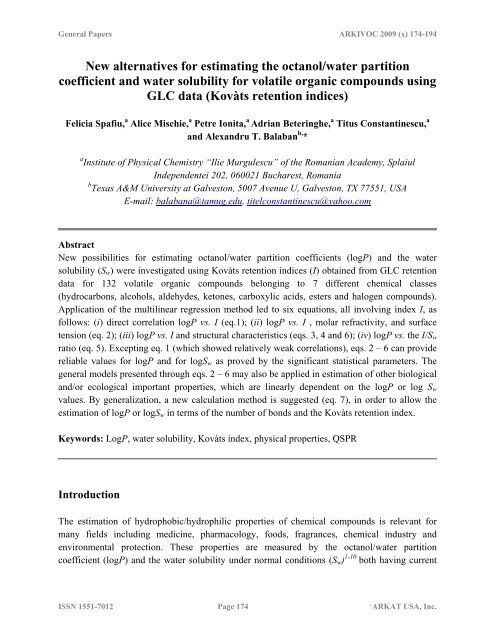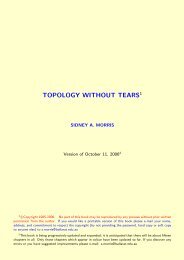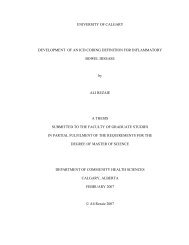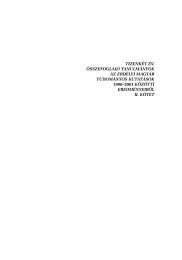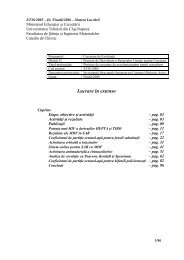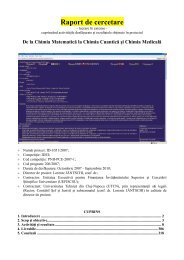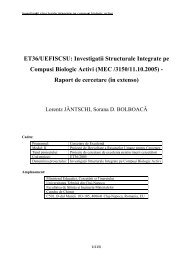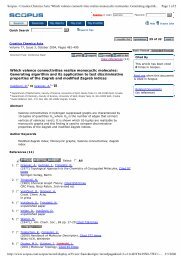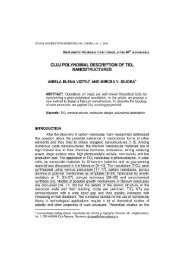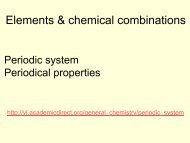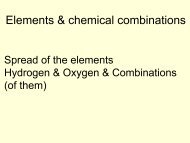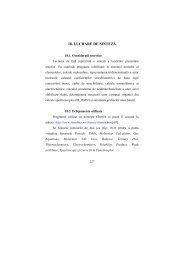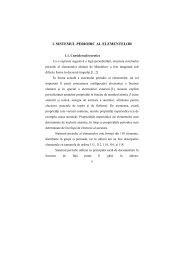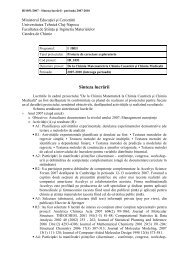New alternatives for estimating the octanol/water partition coefficient ...
New alternatives for estimating the octanol/water partition coefficient ...
New alternatives for estimating the octanol/water partition coefficient ...
You also want an ePaper? Increase the reach of your titles
YUMPU automatically turns print PDFs into web optimized ePapers that Google loves.
General Papers ARKIVOC 2009 (x) 174-194<br />
<strong>New</strong> <strong>alternatives</strong> <strong>for</strong> <strong>estimating</strong> <strong>the</strong> <strong>octanol</strong>/<strong>water</strong> <strong>partition</strong><br />
<strong>coefficient</strong> and <strong>water</strong> solubility <strong>for</strong> volatile organic compounds using<br />
GLC data (Kovàts retention indices)<br />
Felicia Spafiu, a Alice Mischie, a Petre Ionita, a Adrian Beteringhe, a Titus Constantinescu, a<br />
and Alexandru T. Balaban b, *<br />
a<br />
Institute of Physical Chemistry “Ilie Murgulescu” of <strong>the</strong> Romanian Academy, Splaiul<br />
Independentei 202, 060021 Bucharest, Romania<br />
b<br />
Texas A&M University at Galveston, 5007 Avenue U, Galveston, TX 77551, USA<br />
E-mail: balabana@tamug.edu, titelconstantinescu@yahoo.com<br />
Abstract<br />
<strong>New</strong> possibilities <strong>for</strong> <strong>estimating</strong> <strong>octanol</strong>/<strong>water</strong> <strong>partition</strong> <strong>coefficient</strong>s (logP) and <strong>the</strong> <strong>water</strong><br />
solubility (Sw) were investigated using Kovàts retention indices (I) obtained from GLC retention<br />
data <strong>for</strong> 132 volatile organic compounds belonging to 7 different chemical classes<br />
(hydrocarbons, alcohols, aldehydes, ketones, carboxylic acids, esters and halogen compounds).<br />
Application of <strong>the</strong> multilinear regression method led to six equations, all involving index I, as<br />
follows: (i) direct correlation logP vs. I (eq.1); (ii) logP vs. I , molar refractivity, and surface<br />
tension (eq. 2); (iii) logP vs. I and structural characteristics (eqs. 3, 4 and 6); (iv) logP vs. <strong>the</strong> I/Sw<br />
ratio (eq. 5). Excepting eq. 1 (which showed relatively weak correlations), eqs. 2 – 6 can provide<br />
reliable values <strong>for</strong> logP and <strong>for</strong> logSw as proved by <strong>the</strong> significant statistical parameters. The<br />
general models presented through eqs. 2 – 6 may also be applied in estimation of o<strong>the</strong>r biological<br />
and/or ecological important properties, which are linearly dependent on <strong>the</strong> logP or log Sw<br />
values. By generalization, a new calculation method is suggested (eq. 7), in order to allow <strong>the</strong><br />
estimation of logP or logSw in terms of <strong>the</strong> number of bonds and <strong>the</strong> Kovàts retention index.<br />
Keywords: LogP, <strong>water</strong> solubility, Kovàts index, physical properties, QSPR<br />
Introduction<br />
The estimation of hydrophobic/hydrophilic properties of chemical compounds is relevant <strong>for</strong><br />
many fields including medicine, pharmacology, foods, fragrances, chemical industry and<br />
environmental protection. These properties are measured by <strong>the</strong> <strong>octanol</strong>/<strong>water</strong> <strong>partition</strong><br />
<strong>coefficient</strong> (logP) and <strong>the</strong> <strong>water</strong> solubility under normal conditions (Sw) 1-10 both having current<br />
ISSN 1551-7012 Page 174 © ARKAT USA, Inc.
General Papers ARKIVOC 2009 (x) 174-194<br />
applications in <strong>estimating</strong> various characteristics of interest <strong>for</strong> biology and environmental<br />
studies. 11-13<br />
In order to obtain experimental logP values, liquid/liquid (l/l) extraction (<strong>octanol</strong>/<strong>water</strong> or,<br />
generally, organic solvent/<strong>water</strong>) may be applied. As an alternative to this time-consuming<br />
method, <strong>the</strong> Hansch model provides <strong>the</strong> logP values from <strong>the</strong> experimental fragment and bond<br />
increments. 1,2 Besides this, several <strong>the</strong>oretical models <strong>for</strong> predicting logP and logSw values were<br />
proposed . 3-10,14-16 Ano<strong>the</strong>r improvement of <strong>the</strong> classical l/l extraction is offered by reversedphase<br />
liquid chromatography (RP-HPLC) 17,18 and reversed-phase thin-layer chromatography<br />
(RP-TLC), 19-21 which are at present <strong>the</strong> most frequently used techniques <strong>for</strong> providing<br />
experimental values of <strong>the</strong> <strong>octanol</strong>/<strong>water</strong> <strong>partition</strong> <strong>coefficient</strong>s. Such methods are based on <strong>the</strong><br />
linear correlation between logP values of <strong>the</strong> corresponding compounds and <strong>the</strong> capacity factors<br />
(<strong>for</strong> RP-HPLC) or RM0 values (in <strong>the</strong> case of RP-TLC), when reliable correlations are obtained<br />
within homologous series. In <strong>the</strong> case of volatile compounds, gas liquid chromatography (GLC)<br />
may provide more suitable <strong>alternatives</strong>.<br />
The retention index on a certain stationary phase 22 is <strong>the</strong> result of a gas-liquid <strong>partition</strong><br />
process, so that it may contain in<strong>for</strong>mation related to solvation. Such in<strong>for</strong>mation can be<br />
extracted from GLC data, under <strong>the</strong> <strong>for</strong>m of well-known solubility factors, 23-25 which are used <strong>for</strong><br />
<strong>the</strong> calculation of various properties, including logP. Besides this indirect method, only few<br />
attempts of evaluating directly physico-chemical properties from GLC data have been reported, 26<br />
such studies being restricted to polycyclic aromatic derivatives.<br />
The aim of <strong>the</strong> present study is to investigate <strong>the</strong> possibility of <strong>estimating</strong> <strong>the</strong><br />
hydrophobic/hydrophilic properties of organic compounds, namely logP and logSw, from Kovàts<br />
indices (I) <strong>for</strong> a set of 132 organic compounds from 7 different classes. In order to obtain<br />
relationships suitable <strong>for</strong> structurally diverse sets, <strong>the</strong> simple correlations logP vs. I were<br />
improved by addition of o<strong>the</strong>r parameters, such as molar refractivity, surface tension, number of<br />
bonds, accessible polar surface, or <strong>water</strong> solubility.<br />
Results and Discussion<br />
The use of <strong>the</strong> index I <strong>for</strong> estimation of <strong>the</strong> logP value and <strong>water</strong> solubility was carried out in <strong>the</strong><br />
present study as a stepwise strategy, which allowed drawing up of some new linear relationships<br />
between <strong>the</strong> mentioned parameters and <strong>the</strong> index I. The predictability of logP and logSw through<br />
<strong>the</strong> per<strong>for</strong>med models was tested by cross-validation, using <strong>the</strong> leave-one-out method. 27 The<br />
leave-one-out cross-validation <strong>coefficient</strong> (R 2 CV) was provided by <strong>the</strong> CODESSA program. 28<br />
Additionally, <strong>the</strong> quality factor of <strong>the</strong> regressions (Q) was calculated as R/SE. 29,30<br />
The set of compounds and <strong>the</strong> corresponding literature-accessible values <strong>for</strong> logP, 1,31,32<br />
Sw, 6,7,32 and I index 24 are presented in Table 1 (stationary phase polyphenyl e<strong>the</strong>r).<br />
ISSN 1551-7012 Page 175 © ARKAT USA, Inc.
General Papers ARKIVOC 2009 (x) 174-194<br />
Table 1. Experimental values <strong>for</strong> Kovàts index(I), logP and <strong>water</strong> solubility (Sw) <strong>for</strong> <strong>the</strong> studied<br />
set of compounds<br />
Hydrocarbons<br />
Compound logPexp I Sw(mol/l)<br />
1 ethane 1.81 200 2.007×10 -3<br />
2 propane 2.36 300 1.418×10 -3<br />
3 n-butane 2.89 400 1.055×10 -3<br />
4 n-pentane 3.39 500 5.27×10 -4<br />
5 n-hexane 4 600 1.1×10 -4<br />
6 n-heptane 4.5 700 3.39×10 -5<br />
7 n-octane 5.15 800 5.78×10 -6<br />
8 n-nonane 5.65 900 1.72×10 -6<br />
9 n-decane 6.25 1000 3.65E×10 -7<br />
10 n-undecane 6.54 1100 2.81×10 -8<br />
11 n-dodecane 6.8 1200 −<br />
12 n-tridecane 7.5 1300 −<br />
13 n-tetradecane 8 1400 −<br />
14 2-methylpropane 2.76 358 8.4×10 -4<br />
15 3-methylheptane − 774 6.92×10 -6<br />
16 2,4-dimethylpentane − 608 5.49×10 -5<br />
17 ethane 1.13 270 4.67×10 -3<br />
18 propene 1.77 360 4.753×10 -3<br />
19 1-butene 2.4 450 3.939×10 -3<br />
20 1-pentene 2.8 552 2.11×10 -3<br />
21 1-hexene 3.4 614 5.94×10 -4<br />
22 1-heptene 3.99 723 1.85×10 -4<br />
23 1-octene 4.57 819 3.65×10 -5<br />
24 E-2-octene 4.44 849 −<br />
25 2-ethylhexene 4.31 824 −<br />
26 2-butyne 1.46 587 −<br />
27 1-octyne 3.57 907 −<br />
28 2-octyne 3.57 979 −<br />
29 benzene 2.15 833 2.482×10 -2<br />
30 toluene 2.73 938 5.709×10 -3<br />
31 ethylbenzene 3.15 1035 1.592×10 -3<br />
ISSN 1551-7012 Page 176 © ARKAT USA, Inc.
General Papers ARKIVOC 2009 (x) 174-194<br />
32 styrene 2.95 1094 2.976×10 -3<br />
33 ethynylbenzene 2.4 1096 4.464×10 -3<br />
34 o-xylene 3.12 1046 1.677×10 -3<br />
35 m-xylene 3.2 1050 1.51×10 -3<br />
36 p-xylene 3.15 1041 1.52×10 -3<br />
37 mesitylene 3.42 1155 4.01×10 -4<br />
38 α-pinene 4.83 1015 1.83×10 -5<br />
39 cyclohexane 3.44 735 −<br />
Alcohols<br />
40 methanol -0.77 522 31.21<br />
41 ethanol -0.31 587 21.7<br />
42 1-propanol 0.25 703 16.63<br />
43 1-butanol 0.88 820 8.52×10 -1<br />
44 1-pentanol 1.56 929 2.49×10 -1<br />
45 1-hexanol 2.03 1032 5.7×10 -2<br />
46 1-heptanol 2.72 1138 1.43×10 -2<br />
47 1-<strong>octanol</strong> 3.07 1241 4.14×10 -3<br />
48 1-nonanol 4.02 1350 9.7×10 -4<br />
49 1-decanol 4.57 1439 2.34×10 -4<br />
50 1-undecanol 4.72 1569 1.11×10 -4<br />
51 1-dodecanol 5.13 1678 2.15×10 -5<br />
52 2-methyl-1-butanol 1.16 886 3.36×10 -1<br />
53 3-methyl-1-butanol 1.42 885 3.02×10 -1<br />
54 allyl alcohol 0.17 715 17<br />
55 2-hexen-1-ol 1.6 1046 −<br />
56 2-butanol 0.61 737 2.44<br />
57 2-hexanol 1.76 950 1.34×10 -1<br />
58 2-propanol 0.05 613 16.63<br />
59 3-hexanol 1.65 941 −<br />
60 2-methyl-2-propanol 0.35 654 13.49<br />
61 2-methyl-2-butanol 0.89 771 1.13<br />
62 2-methyl-2-pentanol 1.39 868 −<br />
63 3-methyl-3-pentanol 1.41 900 −<br />
64 3-methyl-3-heptanol − 1078 1.83×10 -2<br />
65 α-terpineol 2.98 1426 4.603×10 -3<br />
66 dimethylcyclohexanol 2.37 1173 −<br />
ISSN 1551-7012 Page 177 © ARKAT USA, Inc.
General Papers ARKIVOC 2009 (x) 174-194<br />
67 cyclopentanol 0.78 996 1.5<br />
Aldehydes<br />
68 acetaldehyde -0.22 541 22.7<br />
69 propionaldehyde 0.3 656 5.26<br />
70 butyraldehyde 0.83 753 9.84×10 -1<br />
71 hexanal 1.89 966 5.63×10 -2<br />
72 heptanal 2.42 1066 1.09×10 -2<br />
73 octanal 2.9 1167 4.36×10 -3<br />
74 2-methyl-1-propanal 0.77 706 −<br />
75 propenal -0.01 659 3.78<br />
76 E-2-butenal 0.52 870 2.58<br />
77 E-2-hexenal 1.58 1077 −<br />
78 benzaldehyde 1.48 1272 6.54×10 -2<br />
Ketones<br />
79 acetone -0.24 652 17<br />
80 2-butanone 0.29 764 3.092<br />
81 2-pentanone 0.91 857 4.99×10 -1<br />
82 2-hexanone 1.38 966 1.74×10 -1<br />
83 2-heptanone 1.98 1061 3.76×10 -2<br />
84 2-octanone 2.37 1165 7.01×10 -3<br />
85 2-nonanone 3.14 1264 2.60×10 -3<br />
86 2-decanone 3.73 1366 4.91×10 -4<br />
87 2-undecanone 4.09 1469 1.16×10 -4<br />
88 2-dodecanone 4.55 1571 −<br />
89 3-hexanone 1.45 945 1.46×10 -1<br />
90 cyclopentanone 0.38 1050 −<br />
91 cyclohexanone 0.81 1160 2.54×10 -1<br />
92 cycloundecanone 3.66 1757 −<br />
93 cyclododecanone 4.1 1875 −<br />
94 acetophenone 1.58 1387 5.10×10 -2<br />
95 Carvone 2.52 1566 8.72×10 -3<br />
Carboxylic acids<br />
96 acetic acid -0.17 734 16.65<br />
97 propionic acid 0.33 886 13.49<br />
98 butyric acid 0.79 985 6.80×10 -1<br />
99 valeric acid 1.39 1108 2.34×10 -1<br />
ISSN 1551-7012 Page 178 © ARKAT USA, Inc.
General Papers ARKIVOC 2009 (x) 174-194<br />
100 hexanoic acid 1.92 1233 8.83×10 -2<br />
101 heptanoic acid 2.42 1358 2.16×10 -2<br />
102 octanoic acid 3.05 1483 5.47×10 -3<br />
103 nonanoic acid 3.42 1608 1.79×10 -3<br />
104 decanoic acid 4.09 1733 3.59×10 -4<br />
105 undecanoic acid 4.42 1858 2.80×10 -4<br />
106 dodecanoic acid 4.6 1982 2.4×10 -5<br />
107 2-methylpropionic acid 0.94 945 1.89<br />
108 2-methylbutyric acid 1.18 1094 4.39×10 -1<br />
109 3-methylbutyric acid 1.16 1042 3.97×10 -1<br />
110 4-methylpentanoic acid<br />
Esters<br />
1.79 1148 −<br />
111 methyl acetate 0.18 666 3.28<br />
112 ethyl acetate 0.73 751 9.07×10 -1<br />
113 2-methylbutyl acetate 2.29 1058 −<br />
114 propyl acetate 1.24 844 1.85×10 -1<br />
115 butyl acetate 1.82 958 7.23×10 -2<br />
116 3-methylbutyl acetate 2.25 1010 1.50×10 -2<br />
117 propyl butyrate 2.15 1024 1.24×10 -2<br />
118 methyl propionate 0.82 770 7.08×10 -1<br />
119 propyl <strong>for</strong>mate 0.83 762 2.49×10 -1<br />
120 isobutyl isobutyrate 2.48 1012 −<br />
121 isopentyl isovalerate 3.62 1217 6.93×10 -3<br />
122 benzyl acetate 1.96 1378 2.06×10 -2<br />
123 methyl benzoate 2.23 1442 1.54×10 -2<br />
Halogen compounds<br />
124 1-fluorooctane 4.2 972 1.72×10 -4<br />
125 1-bromoethane 1.61 665 8.25×10 -2<br />
126 1-bromopentane 3.37 973 8.41×10 -4<br />
127 2-bromooctane 4.89 1214 3.26×10 -5<br />
128 iodomethane 1.51 698 9.72×10 -2<br />
129 1-iodobutane 3.08 989 1.09×10 -3<br />
130 2-iodobutane 3.05 946 1.14×10 -3<br />
131 1-chlorohexane 3.66 968 2.95×10 -3<br />
132 o-chlorotoluene 3.42 1273 −<br />
ISSN 1551-7012 Page 179 © ARKAT USA, Inc.
General Papers ARKIVOC 2009 (x) 174-194<br />
1. Estimation of log P using <strong>the</strong> Kovàts retention index (I)<br />
1.1. Simple correlation of <strong>the</strong> log P parameter with <strong>the</strong> Kovàts index(I)<br />
As it may be observed from Figure 1, logP is linearly dependent on index I within various<br />
homologous series. Plotting logP vs. I also shows trends, depending on <strong>the</strong> functional group,<br />
unsaturation, and <strong>the</strong> presence of rings or aromatic structures.<br />
LogP exp.<br />
9.00<br />
8.00<br />
7.00<br />
6.00<br />
5.00<br />
4.00<br />
3.00<br />
2.00<br />
1.00<br />
Halogen compounds<br />
0.00<br />
0 500 1000 1500 2000 2500<br />
-1.00<br />
-2.00<br />
Figure 1. Plot of logP parameter (experimental, Table 1) vs. I.<br />
Hydrocarbons<br />
Alcohols<br />
Aldehydes<br />
Ketones<br />
Carboxylic acids<br />
Esters<br />
In order to obtain linear relationships between logP and I, sets were <strong>for</strong>med according to<br />
functional groups, as shown in Table 1. Because <strong>the</strong> experimental I values presented in Table 1<br />
are about two orders greater than logP, index I was replaced in <strong>the</strong> calculations with <strong>the</strong> ratio<br />
I/100, denoted as I * . Linear regressions were per<strong>for</strong>med according to a general equation (eq. 1),<br />
leading to relatively weak correlations (R 2 = 0.431 – 0.990). Statistics of <strong>the</strong>se correlations are<br />
presented in Table 2.<br />
logP= a×I * + b eq. 1<br />
where: I * = I (Kovàts index, Table 1)/ 100<br />
ISSN 1551-7012 Page 180 © ARKAT USA, Inc.<br />
I
General Papers ARKIVOC 2009 (x) 174-194<br />
Table 2. The <strong>coefficient</strong>s a, b and statistical parameters a (R, F, SE, R 2 CV , Q) in <strong>the</strong> case of eq. 1,<br />
<strong>for</strong> each class of compounds (according to Table 1)<br />
Eq. Class b N a b R 2<br />
F SE R 2 CV Q<br />
1a Hydrocarbons 37 0.352 0.938 0.431 26.52 1.265 0.361 0.518<br />
1b Alcohols 27 0.493 -3.135 0.948 457.5 0.360 0.938 2.702<br />
1c Aldehydes 11 0.462 -1.913 0.703 21.35 0.569 0.508 1.472<br />
1d Ketones 17 0.369 -2.383 0.728 40.28 0.810 0.672 1.053<br />
1e Carboxylic<br />
acids<br />
15 0.400 -3.034 0.990 1299 0.156 0.985 6.371<br />
1f Esters 13 0.292 -1.158 0.568 14.46 0.641 0.358 1.174<br />
1g Halogen<br />
comp.<br />
9 0.446 -1.120 0.666 13.98 0.675 0.382 1.208<br />
( a ) R = Pearson’s correlation <strong>coefficient</strong>; F = Fisher test; SE = standard error; R 2 CV = cross<br />
validated <strong>coefficient</strong>; Q = quality factor.<br />
There are significant differences between <strong>the</strong> correlation parameters corresponding to <strong>the</strong><br />
various classes, but such differences may be due ra<strong>the</strong>r to <strong>the</strong> heterogeneous composition of <strong>the</strong><br />
sets, with respect to <strong>the</strong> olefinic, cyclic or aromatic structures. The best correlation <strong>coefficient</strong>s<br />
were observed in <strong>the</strong> case of alcohols (R 2 =0.948) and carboxylic acids (R 2 =0.990). Such<br />
pronounced linearity may be explained by <strong>the</strong> smaller proportion of unsaturated, cyclic or<br />
aromatic structures within <strong>the</strong>se sets.<br />
1.2. Dependence of <strong>the</strong> log P parameter on <strong>the</strong> Kovàts index(I) and physical properties<br />
(molar refractivity and surface tension)<br />
Eq. 1 was improved, according to <strong>the</strong> general equation 2, by <strong>the</strong> addition of a second parameter,<br />
constructed from two physical properties (molar refractivity and surface tension) which affect <strong>the</strong><br />
<strong>partition</strong> process between <strong>water</strong> and <strong>the</strong> organic solvent. The molar refractivity and surface<br />
tension were computed using <strong>the</strong> ACD ChemSketch 8.0 Freeware software. 33 Coefficients and<br />
statistical parameters of eqs. 2a – 2g, corresponding to each class of compounds, are presented in<br />
Table 3. These results show significant increases of <strong>the</strong> correlation <strong>coefficient</strong>s (R 2 = 0.927 –<br />
0.992). At <strong>the</strong> same time, a good correlation between logP values calculated through eqs. 2a – 2g<br />
and <strong>the</strong> experimental logP is displayed by Figure 2.<br />
logP= a×I * + b×log(MR/ST) + c eq. 2<br />
where: MR = molar refractivity and ST = surface tension.<br />
ISSN 1551-7012 Page 181 © ARKAT USA, Inc.
General Papers ARKIVOC 2009 (x) 174-194<br />
Table 3. Coefficients a, b, c and statistical parameters (R 2 , F, SE, R 2 CV, Q) a in <strong>the</strong> case of eq. 2,<br />
<strong>for</strong> each class of compounds (according to Table 1)<br />
Eq. Class N a b c R 2<br />
F SE R 2 CV Q<br />
2a Hydrocarbons 37 0.134 11.54 0.969 0.927 216.7 0.459 0.912 2.097<br />
2b Alcohols 27 0.402 2.218 -2.315 0.959 283.2 0.325 0.944 3.013<br />
2c Aldehydes 11 0.156 6.214 -0.183 0.938 61.48 0.274 0.890 3.534<br />
2d Ketones 17 0.160 7.145 -0.673 0.958 161.9 0.328 0.928 2.984<br />
2e Carboxylic acids 15 0.330 1.523 -2.113 0.992 839.4 0.137 0.986 7.270<br />
2f Esters 13 0.143 6.581 -0.153 0.970 165.5 0.175 0.922 5.627<br />
2g Halogen comp. 9 0.179 6.402 0.996 0.980 149.3 0.177 0.921 5.592<br />
( a ) R = Pearson’s correlation <strong>coefficient</strong>; F = Fisher test; SE = standard error; R 2 CV = cross<br />
validation <strong>coefficient</strong>; Q = quality factor.<br />
logPcalcd.<br />
8<br />
7<br />
6<br />
5<br />
4<br />
3<br />
2<br />
1<br />
-2.00 -1.00<br />
0<br />
0.00 1.00 2.00 3.00 4.00 5.00 6.00 7.00 8.00 9.00<br />
-1<br />
-2<br />
Hydrocarbons<br />
Alcohols<br />
Aldehydes<br />
Ketones<br />
Carboxylic acids<br />
logPexp<br />
ISSN 1551-7012 Page 182 © ARKAT USA, Inc.<br />
Esters<br />
Halogen compounds<br />
Figure 2. Plot of logP calcd. (eq.2, Table 3) vs. logP exp. (Table 1).<br />
1.3. Dependence of <strong>the</strong> log P parameter on <strong>the</strong> Kovàts index involving structural effects and<br />
accessible polar surface<br />
Ano<strong>the</strong>r improvement of eq. 1 was achieved by a QSPR study. According to <strong>the</strong> observed<br />
influence of <strong>the</strong> molecular structure on <strong>the</strong> dependence logP vs. I (Figure 1), two parameters<br />
were added to eq.1: <strong>the</strong> number of bonds (nBt) 34 in order to characterize <strong>the</strong> effects of<br />
unsaturation, rings, or aromaticity, and <strong>the</strong> accessible polar surface, which may describe <strong>the</strong><br />
availability of <strong>the</strong> functional group to hydration. Ascribing net atomic charges (CNDO) and
General Papers ARKIVOC 2009 (x) 174-194<br />
geometry optimization (MM + <strong>for</strong>ce field) were per<strong>for</strong>med using <strong>the</strong> HyperChem program, 35<br />
followed by computing of <strong>the</strong> accesssible surface of <strong>the</strong> heteroatoms.<br />
As seen in Table 4 and Figure 3, <strong>the</strong> use of <strong>the</strong> number of bonds nBt (a constitutional<br />
descriptor) toge<strong>the</strong>r with index I (eq. 3) led to a significant increase of statistical parameters,<br />
compared to eq.1.<br />
logP= a×I * + b×nBt + c eq. 3<br />
where nBt = number of bonds.<br />
Table 4. The <strong>coefficient</strong>s a, b and statistical parameters a (R, F, SE, R 2 CV, Q) in <strong>the</strong> case of eq. 3,<br />
<strong>for</strong> each class of compounds (according to Table 1)<br />
Eq. Class N a b c R 2<br />
F SE R 2 CV Q<br />
3a Hydrocarbons 37 -0.118 0.213 0.517 0.990 1842 0.162 0.979 6.141<br />
3b Alcohols 27 0.183 0.119 -2.414 0.970 399.7 0.275 0.961 3.583<br />
3c Aldehydes 11 0.057 0.152 -1.418 0.988 334.4 0.120 0.976 8.284<br />
3d ketones 17 -0.031 0.187 -1.686 0.984 443.5 0.200 0.970 4.959<br />
3e Carboxylic<br />
acids<br />
15 0.201 0.082 -2.170 0.993 889.5 0.133 0.988 7.493<br />
3f Esters 13 0.079 0.134 -1.586 0.975 200.1 0.160 0.915 6.171<br />
3g Halogen<br />
comp.<br />
9 0.152 0.118 -0.084 0.982 171.3 0.165 0.923 6.005<br />
( a ) R = Pearson’s correlation <strong>coefficient</strong>; F = Fisher test; SE = standard error; R 2 CV = cross<br />
validation <strong>coefficient</strong>; Q = quality factor.<br />
LogP calcd.<br />
9<br />
8<br />
7<br />
6<br />
5<br />
4<br />
3<br />
2<br />
1<br />
-2.00 -1.00<br />
0<br />
0.00 1.00 2.00 3.00 4.00 5.00 6.00 7.00 8.00 9.00<br />
-1<br />
-2<br />
Hydrocarbons<br />
Alcohols<br />
Aldehydes<br />
Ketones<br />
Carboxylic acids<br />
LogP exp<br />
ISSN 1551-7012 Page 183 © ARKAT USA, Inc.<br />
Esters<br />
Halogen compounds<br />
Figure 3. Plot of logP calc (eq. 3, Table 4) vs .logP exp. (Table 1).
General Papers ARKIVOC 2009 (x) 174-194<br />
Attempts were made <strong>for</strong> finding a unique relationship able to predict logP of all <strong>the</strong> 129<br />
compounds (<strong>for</strong> which experimental logP was available, Table 1), independent of <strong>the</strong> type of <strong>the</strong><br />
functional group. In this case, supplementary characteristics of <strong>the</strong> functional group are required<br />
<strong>for</strong> <strong>the</strong>se compounds. The accessible polar surface was found to be <strong>the</strong> best from several tested<br />
descriptors. It was included in <strong>the</strong> QSPR model (eq. 4) as a substituent factor (SF), only in <strong>the</strong><br />
case of heteroatom-containing structures. Satisfactory statistics could be achieved only by adding<br />
an indicator variable (V) to <strong>the</strong> QSPR model, so that V has value “1” <strong>for</strong> those structures which<br />
contain oxygen atoms, and “0” <strong>for</strong> <strong>the</strong> o<strong>the</strong>r ones.<br />
logP = 0.031 × I * + 0.185 × nBt + 6.05 ×10 -3 ×SF + 0.353 ×V eq.4<br />
N = 129; R 2 = 0.974; F = 1194.4, SE= 0.275, R 2 CV =0.969, Q=3.840<br />
where: I * = I (Kovats index, Table 1)/100, nBt = number of bonds, SF = Sp = solvent accessible<br />
surface of <strong>the</strong> heteroatoms; <strong>for</strong> hydrocarbons, SF = 0; V = 1 <strong>for</strong> compounds containing oxygen<br />
atoms, and V = 0 <strong>for</strong> <strong>the</strong> o<strong>the</strong>r ones.<br />
In Figure 4 <strong>the</strong> logPcalcd. values (calculated via eq. 4) are plotted against <strong>the</strong> experimental<br />
values logPexp.<br />
LogP calcd.<br />
9.00<br />
8.00<br />
7.00<br />
6.00<br />
5.00<br />
4.00<br />
3.00<br />
2.00<br />
1.00<br />
-2.00 -1.00<br />
0.00<br />
0.00 1.00 2.00 3.00 4.00 5.00 6.00 7.00 8.00 9.00<br />
-1.00<br />
-2.00<br />
Figure 4. Plot of logPcalcd. (eq.4) vs. logPexp (Table 1)<br />
Hydrocarbons<br />
Alcohols<br />
Aldehydes<br />
Ketones<br />
Carboxylic acids<br />
Esters<br />
Halogen compounds<br />
LogP exp.<br />
Although R is slightly lower than in <strong>the</strong> case of eqs.3a – 3g, <strong>the</strong> statistical parameters of eq. 4<br />
(R 2 = 0.974, F = 1194.4, SE = 0.275) may be considered relatively good, taking into account <strong>the</strong><br />
number and <strong>the</strong> chemical diversity of <strong>the</strong> structures covered by this relationship.<br />
When “1” value was assigned to variable V <strong>for</strong> both oxygen- and fluorine-substituted<br />
compounds, no improvement was observed (R 2 = 0.971, F = 1065, SE = 0.291). Taking into<br />
ISSN 1551-7012 Page 184 © ARKAT USA, Inc.
General Papers ARKIVOC 2009 (x) 174-194<br />
account <strong>the</strong> hydrogen bond acceptor character of <strong>the</strong> fluorine atoms, an improvement of <strong>the</strong><br />
statistics <strong>for</strong> equation 4 should be expected, if <strong>the</strong> variable V is related to hydrogen bonding.<br />
Such a result suggests that variable V is related ra<strong>the</strong>r to <strong>the</strong> Brønsted acid-base behavior of <strong>the</strong><br />
oxygen-containing compounds.<br />
1.4 Dependence of <strong>the</strong> logP parameter on index I and <strong>water</strong> solubility<br />
As it is known, 1,2 logP involves <strong>the</strong> <strong>partition</strong> of a chemical compound between an organic solvent<br />
(usually 1-<strong>octanol</strong>) and <strong>water</strong>. Starting from this basic notion, we attempted to correlate logP<br />
values with <strong>the</strong> ratios I/Sw, where Sw represents <strong>the</strong> <strong>water</strong> solubility (eq. 5a, obtained using those<br />
compounds <strong>for</strong> which both <strong>the</strong> experimental logP and Sw were available, Table 1). Such a<br />
strategy may offer an easily accessible method <strong>for</strong> measuring logP, being related to <strong>the</strong> real<br />
<strong>partition</strong> process (organic phase/<strong>water</strong>). A plot of logP calculated (eq. 5a) and <strong>the</strong> experimental<br />
logP is presented in Figure 5.<br />
LogP calcd.<br />
8<br />
7<br />
6<br />
5<br />
4<br />
3<br />
2<br />
1<br />
0<br />
-2 -1 0 1 2 3 4 5 6 7<br />
-1<br />
Figure 5. Plot of <strong>the</strong> logP calcd. (eq.5a) vs. log P exp. (Table 1).<br />
Hydrocarbons<br />
Alcohols<br />
Aldehydes<br />
Ketones<br />
Carboxylic acids<br />
LogP exp.<br />
ISSN 1551-7012 Page 185 © ARKAT USA, Inc.<br />
Esters<br />
Halogen compounds<br />
logP= 0.809 ×log(I * /Sw) + 0.066 eq. 5a<br />
N = 105; R 2 = 0.969; F = 3183,72; SE = 0.281; R 2 CV = 0.965; Q=3.501<br />
where Sw = experimental <strong>water</strong> solubility.<br />
The resulted correlation equation (eq. 5a) was compared to Yalkowsky’s equation applied to<br />
<strong>the</strong> same set of compounds (eq. 5b), 4 showing an improvement of statistical parameters, when <strong>the</strong>
General Papers ARKIVOC 2009 (x) 174-194<br />
Kovàts index is used toge<strong>the</strong>r with <strong>water</strong> solubility. The improvement added by <strong>the</strong> retention<br />
index (which is related to <strong>the</strong> solubility in <strong>the</strong> organic phase) may depend on <strong>the</strong> stationary<br />
phase.<br />
logP= −0.823 × logSw + 0.812 eq.5b<br />
N = 105; R 2 = 0.950; F = 1981,84; SE = 0.353; R 2 CV = 0.949; Q = 2.762<br />
2. Estimation of <strong>water</strong> solubility on <strong>the</strong> basis of Kovàts retention indices<br />
The linear dependence between logP and Sw discussed above is due to <strong>the</strong> physico-chemical<br />
definition of <strong>the</strong> logP parameter, i. e. <strong>the</strong> organic phase/<strong>water</strong> <strong>partition</strong>. Based on such a<br />
relationship, logSw may be expressed as a linear function of <strong>the</strong> same parameters that describe<br />
logP. Thus, <strong>the</strong> general model represented by eq.3 (which gave <strong>the</strong> best results from all <strong>the</strong> tested<br />
models) was applied <strong>for</strong> estimation of logSw, resulting in eq. 6:<br />
logSw = a×I * + b×nBt + c eq. 6<br />
where: I * = I (Kovàts index, Table 1)/100, nBt = number of bonds.<br />
Table 5. Coefficients a, b, c and statistical parameters (R, F, SE, R 2 CV, Q) in <strong>the</strong> case of eq. 6, <strong>for</strong><br />
each class of compounds (according to Table 1)<br />
Eq. Class N a b c<br />
F SE R 2 CV Q<br />
6a Hydrocarbons 30 0.217 −0.236 −0.93 0.931 184.4 0.372 0.905 2.593<br />
6b Alcohols 23 −0.222 −0.122 3.76 0.972 358.3 0.317 0.961 3.110<br />
6c Aldehydes 9 −0.255 −0.120 3.41 0.977 131.32 0.232 0.959 4.260<br />
6d Ketones 13 −0.045 −0.138 3.15 0.983 289.9 0.208 0.945 4.766<br />
6e Carboxylic<br />
acids<br />
14 −0.267 −0.081 3.74 0.986 239.3 0.230 0.982 4.317<br />
6f Esters 11 −0.101 −0.144 2.45 0.952 79.62 0.220 0.898 4.435<br />
6g Halogen comp. 8 −0.408 0.068 2.05 0.987 201.47 0.156 0.954 6.368<br />
( a ) R = Pearson’s correlation <strong>coefficient</strong>; F = Fisher test; SE = standard error; R 2 CV = cross<br />
validation <strong>coefficient</strong>; Q = quality factor.<br />
ISSN 1551-7012 Page 186 © ARKAT USA, Inc.<br />
R 2
General Papers ARKIVOC 2009 (x) 174-194<br />
LogSw calcd.<br />
3<br />
2<br />
1<br />
0<br />
-1<br />
-2<br />
-3<br />
-4<br />
-5<br />
-6<br />
-9 -8 -7 -6 -5 -4 -3 -2 -1 0 1 2<br />
-7<br />
Figure 6. LogSw calcd. (eq. 6, Table 5), vs. logSw exp.<br />
Hydrocarbons<br />
Alcohols<br />
Aldehydes<br />
Ketones<br />
Carboxylic acids<br />
Esters<br />
Halogen compounds<br />
LogSw exp<br />
The <strong>coefficient</strong>s of eq. 6, corresponding to each class of compounds from table 1, and <strong>the</strong><br />
statistical parameters are presented in Table 5. This result, toge<strong>the</strong>r with <strong>the</strong> plot of logSwcalcd<br />
vs. logSwexp. (Figure 6), augment <strong>the</strong> validity of such a model <strong>for</strong> <strong>estimating</strong> <strong>the</strong> <strong>water</strong> solubility<br />
of various compounds.<br />
Because both parameters logP and logSw can be expressed by <strong>the</strong> same QSPR model<br />
involving index I, a new general relationship, suitable <strong>for</strong> <strong>the</strong> estimation of logP or logSw, is<br />
proposed as eq. 7:<br />
logP or logSw= a×I * + b×nBt + c eq.7<br />
where <strong>the</strong> definitons of I * , and nBt are those specified <strong>for</strong> eq. 3 and eq. 6.<br />
Values of <strong>the</strong> <strong>coefficient</strong>s a, b, c have been already presented <strong>for</strong> each calculated property<br />
and <strong>for</strong> each class of compounds from Table 1.<br />
The present study based on <strong>the</strong> correlation between logP and Kovàts index underlines <strong>the</strong><br />
possibility of using GLC <strong>for</strong> <strong>the</strong> estimation of <strong>the</strong> <strong>octanol</strong>/<strong>water</strong> <strong>partition</strong> <strong>coefficient</strong>s instead of<br />
liquid chromatography, in <strong>the</strong> case of volatile compounds. The linear relationship between <strong>the</strong>se<br />
two parameters within homologous series could be extended to more general relationships,<br />
applicable to sets of increased structural diversity (eqs. 2 – 5). In <strong>the</strong> present work, several<br />
descriptors related to <strong>the</strong> physico-chemical properties of <strong>the</strong> solutes were tested, but many o<strong>the</strong>r<br />
descriptors may give significant results. 34,36<br />
ISSN 1551-7012 Page 187 © ARKAT USA, Inc.
General Papers ARKIVOC 2009 (x) 174-194<br />
The intercorrelation of parameters is presented in Table 6 <strong>for</strong> <strong>the</strong> most general models,<br />
covering large datasets, namely <strong>for</strong> eq. 4 (Table 6a) and eq. 5a (Table 6b).<br />
Table 6. Intercorrelation of parameters <strong>for</strong> eqs. 4 (6a) and 5a (6b)<br />
(6a)<br />
logP I *<br />
nBt Sp V<br />
logP 1<br />
I *<br />
0.458 1<br />
nBt 0.817 0.769 1<br />
Sp -0.311 0.265 -0.147 1<br />
V<br />
(6b)<br />
-0.523 0.337 0.030 0.436 1<br />
logP logSw logI *<br />
logP 1<br />
logSw −0.975 1<br />
logI *<br />
0.438 −0.329 1<br />
Excepting <strong>the</strong> negative significant intercorrelation between logP and logSw, no o<strong>the</strong>r<br />
intercorrelation can be seen in Tables 6a and 6b. More pronounced intercorrelations of <strong>the</strong><br />
descriptors may occur within particular sets from Table 1. Randić’s orthogonalization procedure<br />
can be applied to <strong>the</strong> collinear parameters <strong>for</strong> each equation within each class of compounds.<br />
According to Randić, 37,38 orthogonalization of descriptors does not affect <strong>the</strong> statistical<br />
parameters (R, F, SE) which are <strong>the</strong> same <strong>for</strong> both orthogonal and nonorthogonal models. The<br />
main reasons <strong>for</strong> using orthogonal descriptors are <strong>the</strong> stability and significance of <strong>the</strong> equation’s<br />
<strong>coefficient</strong>s. Analysis of <strong>the</strong> parameters and of <strong>the</strong> <strong>coefficient</strong>s of <strong>the</strong> presented equations,<br />
employing orthogonal models, on several stationary phases, and using larger data sets, will be<br />
<strong>the</strong> subject of a more detailed future study.<br />
A comparison between <strong>the</strong> <strong>estimating</strong> abilities of <strong>the</strong> proposed models towards ClogP 1,31 and<br />
several known QSPR models (eg. AlogP, 14 MlogP 15 and ACDlabs 33 ) can be made through <strong>the</strong><br />
residuals between <strong>the</strong> experimental and <strong>the</strong> calculated logP and logSw values, as presented in<br />
Table 7.<br />
ISSN 1551-7012 Page 188 © ARKAT USA, Inc.
General Papers ARKIVOC 2009 (x) 174-194<br />
Table 7. Residuals of <strong>the</strong> experimental logP and logSw values towards <strong>the</strong> corresponding values<br />
calculated through eq. 2 − 6, and through some already known QSPR models<br />
LogP LogSw<br />
Compound ClogP AlogP a MlogP a Eq2 Eq.3 Eq.4 Eq.5 ACD Eq.6<br />
1 ethane 0.06 0.53 0.05 0.34 0.03 0.22 -0.68 0.69 -0.55<br />
2 propane 0.08 0.62 0.08 0.37 0.06 0.25 -0.40 0.43 -0.21<br />
3 n-butane 0.08 0.69 0.16 0.34 0.07 0.26 -0.07 0.12 0.15<br />
4 n-pentane 0.05 0.74 0.25 0.25 0.04 0.23 0.11 -0.09 0.34<br />
5 n-hexane 0.13 0.89 0.48 0.30 0.13 0.32 0.10 0.04 0.16<br />
6 n-heptane 0.11 0.94 0.63 0.25 0.11 0.30 0.13 -0.04 0.14<br />
7 n-octane 0.23 1.13 0.95 0.36 0.24 0.42 0.11 1.07 -0.14<br />
8 n-nonane 0.20 1.17 1.13 0.36 0.21 0.40 0.15 -0.09 -0.18<br />
9 n-decane 0.27 1.86 1.43 0.49 0.29 0.47 0.17 -0.13 -0.36<br />
10 n-undecane 0.03 1.15 1.43 0.31 0.06 0.24 -0.48 0.17 -0.98<br />
11 n-dodecane -0.24 0.95 1.40 0.14 -0.21 -0.02 − − −<br />
12 n-tridecane -0.07 1.20 1.83 0.42 -0.03 0.15 − − −<br />
13 n-tetradecane -0.10 1.24 2.07 0.52 -0.05 0.13 − − −<br />
14 2-methylpropane 0.08 0.77 0.03 -0.10 -0.11 0.11 -0.24 0.38 0.15<br />
15 3-methylheptane − − − − − − − 0.16 -0.01<br />
16 2,4-dimethylpentane − − − − − − − 0.09 0.54<br />
17 e<strong>the</strong>ne -0.14 0.18 0.43 -0.75 -0.14 -0.06 -1.17 0.79 -0.81<br />
18 propene -0.02 0.46 0.55 -0.39 -0.03 0.05 -0.63 0.40 -0.29<br />
19 1-butene 0.07 0.59 0.73 -0.27 0.06 0.15 -0.14 0.05 0.15<br />
20 1-pentene -0.05 0.54 0.72 -0.43 -0.06 0.03 -0.03 -0.18 0.36<br />
21 1-hexene 0.02 0.68 0.94 -0.33 -0.02 0.09 0.09 -0.15 0.38<br />
22 1-heptene 0.08 0.82 1.18 -0.30 0.05 0.16 0.21 -0.23 0.35<br />
23 1-octene 0.13 0.94 1.42 -0.23 0.11 0.22 0.17 -0.15 0.15<br />
24 E-2-octene 0.01 0.86 1.29 -0.36 0.02 0.10 − − −<br />
25 2-ethylhexene -0.02 0.69 1.16 -0.66 -0.15 -0.04 − − −<br />
26 2-butyne 0.01 -0.41 -0.21 0.64 -0.29 -0.37 − − −<br />
27 1-octyne -0.03 -0.64 0.42 -0.16 -0.36 -0.38 − − −<br />
28 2-octyne -0.01 -0.13 0.42 -0.28 -0.26 -0.36 − − −<br />
29 benzene 0.01 0.32 -0.11 0.53 0.05 -0.16 0.04 -0.35 0.35<br />
30 toluene 0.09 0.41 0.12 0.13 0.12 -0.10 0.06 -0.17 0.19<br />
31 ethylbenzene -0.02 0.38 0.21 -0.26 0.01 -0.21 0.00 -0.16 0.13<br />
32 styrene 0.09 0.57 0.10 -0.52 0.31 -0.02 0.00 0.09 -0.19<br />
33 ethynylbenzene -0.01 -0.56 -0.45 0.27 0.19 -0.20 -0.41 0.26 -0.50<br />
34 o-xylene 0.03 0.32 0.18 -0.37 -0.01 -0.23 -0.02 -0.15 0.13<br />
35 m-xylene 0.06 0.40 0.26 -0.29 0.08 -0.15 0.03 -0.10 0.08<br />
36 p-xylene 0.01 0.35 0.21 -0.33 0.02 -0.21 -0.02 -0.10 0.10<br />
ISSN 1551-7012 Page 189 © ARKAT USA, Inc.
General Papers ARKIVOC 2009 (x) 174-194<br />
37 mesitylene -0.22 0.13 0.16 -0.85 -0.22 -0.46 -0.25 -0.06 -0.02<br />
38 α-pinene 0.13 1.96 1.46 -0.27 -0.26 -0.20 0.12 0.50 0.36<br />
39 cyclohexane 0.09 0.70 0.32 1.16 -0.06 -0.01 − − −<br />
40 methanol -0.01 -0.41 0.04 0.24 0.09 -0.05 -0.21 -0.62 -0.49<br />
41 ethanol -0.07 -0.30 -0.14 0.18 0.07 -0.09 0.08 -0.74 -0.14<br />
42 1-propanol -0.04 -0.27 -0.10 0.06 0.06 -0.05 0.49 -1.01 0.38<br />
43 1-butanol 0.06 -0.09 0.08 0.05 0.11 0.06 0.02 -0.13 -0.29<br />
44 1-pentanol 0.21 0.13 0.35 0.15 0.23 0.22 0.22 -0.04 -0.21<br />
45 1-hexanol 0.15 0.15 0.44 0.08 0.15 0.17 0.14 0.14 -0.25<br />
46 1-heptanol 0.31 0.38 0.78 0.23 0.29 0.33 0.31 0.26 -0.25<br />
47 1-<strong>octanol</strong> 0.13 0.27 -0.12 0.07 0.09 0.16 0.19 0.29 -0.19<br />
48 1-nonanol 0.55 0.77 0.52 0.49 0.48 0.59 0.60 0.37 -0.21<br />
49 1-decanol 0.57 0.86 0.76 0.60 0.51 0.61 0.63 0.44 -0.26<br />
50 1-undecanol 0.19 0.56 0.62 0.15 0.06 0.25 0.49 0.19 0.07<br />
51 1-dodecanol 0.07 0.51 0.75 0.05 -0.09 0.14 0.30 0.28 -0.03<br />
52 2-methyl-1-butanol -0.06 -0.05 -0.13 -0.13 -0.09 -0.16 -0.06 0.00 -0.17<br />
53 3-methyl-1-butanol 0.20 0.20 0.21 0.14 0.17 0.07 0.17 0.05 -0.22<br />
54 allyl alcohol 0.16 -0.09 -0.03 -0.53 0.19 0.24 0.41 -0.92 0.17<br />
55 2-hexen-1-ol 0.00 0.03 0.16 -0.38 -0.06 0.11 − − −<br />
56 2-butanol 0.01 -0.28 -0.19 0.03 -0.01 -0.22 0.16 -0.42 -0.01<br />
57 2-hexanol 0.10 -0.04 0.17 0.10 0.04 -0.09 0.20 -0.05 -0.06<br />
58 2-propanol -0.02 -0.32 -0.30 0.15 0.02 -0.27 0.33 -0.85 0.18<br />
59 3-hexanol -0.01 -0.22 0.06 0.02 -0.06 -0.17 − − −<br />
60 2-methyl-2-propanol -0.12 -0.22 -0.45 0.10 -0.11 -0.50 0.54 -1.01 0.54<br />
61 2-methyl-2-butanol -0.11 -0.21 -0.32 0.04 -0.15 -0.47 0.15 -0.37 0.10<br />
62 2-methyl-2-pentanol -0.14 -0.16 -0.20 0.03 -0.18 -0.50 − − −<br />
63 3-methyl-3-pentanol -0.12 -0.21 -0.18 -0.07 -0.22 -0.44 − − −<br />
64 3-methyl-3-heptanol − − − − − − − -0.03 0.10<br />
65 α-terpineol 0.35 0.57 0.62 -0.78 -0.70 -0.37 0.09 0.54 0.64<br />
66 dimethylcyclohexanol 0.07 0.23 0.49 -0.40 -0.36 -0.32 − − −<br />
67 cyclopentanol 0.07 -0.26 -0.04 -0.68 -0.55 -0.34 0.05 -0.19 0.60<br />
68 acetaldehyde -0.12 -0.04 0.10 0.29 -0.14 0.25 0.22 -0.57 0.04<br />
69 propionaldehyde 0.29 -0.18 0.10 0.12 0.26 0.25 0.16 -0.55 0.07<br />
70 butyraldehyde 0.05 -0.11 0.18 0.07 0.04 0.25 0.05 -0.41 -0.05<br />
71 hexanal -0.11 0.04 0.45 0.08 -0.09 0.27 0.02 -0.32 -0.03<br />
72 heptanal 0.00 0.11 0.63 0.16 0.03 0.28 -0.06 -0.18 -0.12<br />
73 octanal -0.05 0.14 -0.14 0.22 0.00 0.23 0.11 -0.28 0.10<br />
74 2-methyl-1-propanal 0.06 -0.18 0.12 -0.10 0.02 0.22 − − −<br />
75 propenal 0.00 -0.53 -0.10 -0.20 -0.03 0.31 -0.27 -0.12 -0.31<br />
76 E-2-butenal -0.02 -0.40 -0.03 -0.38 -0.08 0.35 0.03 -0.70 0.42<br />
ISSN 1551-7012 Page 190 © ARKAT USA, Inc.
General Papers ARKIVOC 2009 (x) 174-194<br />
77 E-2-hexenal -0.02 -0.25 0.25 -0.35 -0.05 0.36 − − −<br />
78 benzaldehyde 0.02 -0.11 -0.29 0.10 0.06 0.73 -0.44 -0.45 -0.12<br />
79 acetone -0.03 0.00 -0.44 -0.11 -0.04 -0.28 0.03 -0.97 0.16<br />
80 2-butanone -0.03 -0.13 -0.37 -0.20 -0.04 -0.26 -0.09 -0.69 0.05<br />
81 2-pentanone 0.06 0.03 -0.15 -0.14 0.05 -0.17 -0.16 -0.36 -0.13<br />
82 2-hexanone 0.00 0.04 -0.06 -0.19 -0.01 -0.22 -0.10 -0.36 0.03<br />
83 2-heptanone 0.07 0.19 0.19 -0.07 0.06 -0.15 -0.07 -0.16 -0.02<br />
84 2-octanone -0.07 0.24 0.12 -0.12 -0.08 -0.28 -0.30 0.11 -0.13<br />
85 2-nonanone 0.17 0.44 -0.22 0.22 0.15 -0.03 0.09 0.09 0.06<br />
86 2-decanone 0.23 0.57 0.07 0.40 0.21 0.04 0.07 0.35 -0.05<br />
87 2-undecanone 0.07 0.47 0.14 0.36 0.04 -0.13 -0.11 0.52 -0.06<br />
88 2-dodecanone 0.00 0.48 0.32 0.45 -0.03 -0.19 − − −<br />
89 3-hexanone 0.07 -0.10 0.01 -0.09 0.05 -0.07 -0.08 -0.29 -0.06<br />
90 cyclopentanone 0.07 -0.34 -0.29 0.58 -0.23 -0.36 − − −<br />
91 cyclohexanone -0.05 -0.36 -0.24 0.12 -0.33 -0.55 -0.60 -0.08 0.14<br />
92 cycloundecanone 0.00 0.21 1.01 -0.19 -0.11 -0.26 − − −<br />
93 cyclododecanone -0.12 0.19 1.17 -0.24 -0.20 -0.35 − − −<br />
94 acetophenone 0.00 0.01 -0.52 -0.15 0.51 0.34 0.05 -0.86 -0.41<br />
95 carvone 0.32 0.16 0.37 -0.63 0.00 -0.13 0.41 0.17 0.41<br />
96 acetic acid 0.02 0.06 0.22 0.12 -0.06 0.04 -0.21 0.00 -0.02<br />
97 propionic acid 0.00 -0.11 0.20 -0.08 -0.12 0.07 -0.03 -0.52 0.53<br />
98 butyric acid -0.07 -0.10 0.20 -0.10 -0.11 0.01 0.12 0.17 -0.26<br />
99 valeric acid 0.00 0.04 0.39 -0.04 0.00 0.10 0.09 0.06 -0.15<br />
100 hexanoic acid 0.00 0.11 0.55 -0.01 0.03 0.11 0.21 -0.06 0.00<br />
101 heptanoic acid -0.03 0.16 0.69 -0.02 0.02 0.09 0.16 0.03 -0.04<br />
102 octanoic acid 0.07 0.33 0.08 0.12 0.15 0.21 0.23 0.15 -0.06<br />
103 nonanoic acid -0.09 0.25 0.13 0.01 0.02 0.06 0.45 0.18 0.03<br />
104 decanoic acid 0.05 0.46 0.50 0.20 0.19 0.22 -0.25 0.45 -0.10<br />
105 undecanoic acid -0.15 0.33 0.54 0.06 0.02 0.03 0.31 0.18 0.37<br />
106 dodecanoic acid -0.50 0.06 0.44 -0.22 -0.30 -0.28 -0.02 0.87 -0.13<br />
107 2-methylpropionic acid 0.30 0.35 0.04 0.14 0.12 0.18 -0.05 -0.19 0.08<br />
108 2-methylbutyric acid 0.00 -0.18 0.18 -0.23 0.06 0.46 0.05 -0.12 -0.16<br />
109 3-methylbutyric acid -0.10 0.01 0.16 -0.07 -0.10 -0.13 0.41 -0.08 -0.10<br />
110 4-methylpentanoic acid 0.00 0.19 0.42 0.11 0.07 -0.05 − − −<br />
111 methyl acetate 0.00 0.16 0.05 -0.03 -0.11 -0.13 -0.13 -0.20 0.18<br />
112 ethyl acetate 0.02 0.36 0.14 -0.05 -0.03 -0.08 -0.08 -0.20 0.14<br />
113 2-methylbutyl acetate -0.01 0.48 0.56 0.05 0.07 -0.09 − − −<br />
114 propyl acetate 0.00 0.35 0.24 -0.06 0.00 -0.10 -0.17 -0.06 -0.02<br />
115 butyl acetate 0.05 0.47 0.45 0.02 0.09 -0.03 0.04 -0.16 0.12<br />
116 3-methylbutyl acetate -0.05 0.65 0.52 -0.04 0.07 -0.14 -0.10 0.11 -0.06<br />
ISSN 1551-7012 Page 191 © ARKAT USA, Inc.
General Papers ARKIVOC 2009 (x) 174-194<br />
117 propyl butyrate 1.44 0.13 0.42 -0.04 -0.04 -0.14 -0.28 0.11 -0.14<br />
118 methyl propionate 0.03 0.13 0.23 0.01 0.04 0.02 -0.08 -0.09 0.06<br />
119 propyl <strong>for</strong>mate -1.42 -0.02 0.24 0.19 0.06 0.00 -0.44 0.29 -0.40<br />
120 isobutyl isobutyrate 0.00 0.14 0.42 -0.18 -0.10 -0.33 -0.15 0.07 0.03<br />
121 isopentyl isovalerate 0.00 0.64 0.94 0.23 0.07 -0.23 − − −<br />
122 benzyl acetate 0.00 0.36 -0.12 -0.31 -0.37 -0.09 -0.39 -0.40 0.29<br />
123 methyl benzoate 0.12 0.55 0.20 0.19 0.25 0.84 -0.24 -0.20 -0.21<br />
124 1-florooctane 0.00 0.30 0.25 -0.14 -0.17 -0.70 0.29 -0.01 -0.12<br />
125 1-bromoethane 0.00 0.54 0.59 -0.05 -0.15 -0.35 0.00 -0.03 0.08<br />
126 1-bromopentane 0.18 -0.01 0.20 0.06 0.07 -0.12 0.02 0.12 -0.04<br />
127 2-bromooctane 0.11 0.46 -0.16 0.31 0.15 -0.14 0.32 0.04 0.18<br />
128 iodomethane 0.05 0.27 0.01 0.15 0.06 0.00 -0.06 0.01 0.08<br />
129 1-iodobutane 0.03 0.59 0.59 -0.02 0.11 0.07 -0.19 0.16 -0.06<br />
130 2-iodobutane 0.00 0.82 1.13 -0.11 0.15 0.08 -0.19 0.34 -0.22<br />
131 1-chlorohexane 0.08 -0.01 0.15 -0.04 0.01 -0.30 0.27 -0.58 0.10<br />
132 o-chlorotoluene 0.07 0.23 0.48 -0.17 -0.22 0.33 − − −<br />
Average absolute deviation 0.11 0.39 0.41 0.23 0.12 0.21 0.16 0.24 0.16<br />
a Values <strong>for</strong> AlogP and MlogP were available by using <strong>the</strong> Dragon software. 39<br />
In order to compare <strong>the</strong> presented results with <strong>the</strong> data calculated by <strong>the</strong> mentioned<br />
softwares, an average absolute deviation <strong>for</strong> <strong>the</strong> considered set was calculated <strong>for</strong> each model.<br />
According to Table 7, average absolute deviations are smaller <strong>for</strong> eqs. 2 − 5 than <strong>for</strong> AlogP<br />
and MolgP, and in <strong>the</strong> case of eq.3 <strong>the</strong>y are almost equal with those <strong>for</strong> ClogP. For <strong>the</strong><br />
calculation of logSw, eq. 6 shows better results compared to <strong>the</strong> ACDlabs software.<br />
Conclusions<br />
Studying <strong>the</strong> possibility of estimation <strong>the</strong> <strong>octanol</strong>-<strong>water</strong> <strong>partition</strong> <strong>coefficient</strong>s and <strong>water</strong> solubility<br />
starting from GLC data (Kovàts retention indices) in <strong>the</strong> case of 132 volatile compounds,<br />
belonging to seven different chemical classes, six equations were <strong>for</strong>mulated involving <strong>the</strong><br />
Kovàts index and additional parameters, namely molar refractivity and surface tension (eq. 2),<br />
number of bonds (eq.3 and 6), accessible polar surface (eq.4) and <strong>the</strong> I/Sw ratio (eq. 5a). As a<br />
generalization of <strong>the</strong> per<strong>for</strong>med study, a new model (eq. 7) was proposed in order to estimate<br />
ei<strong>the</strong>r logP or log Sw in terms of <strong>the</strong> Kovàts index and number of bonds. The linear relationship<br />
between logP and <strong>the</strong> Kovàts index <strong>for</strong>mulated through eqs. 2 – 6, with R 2 values between 0.927<br />
and 0.993, proves that GLC may offer a facile alternative <strong>for</strong> <strong>the</strong> estimation of <strong>the</strong> <strong>octanol</strong>/<strong>water</strong><br />
<strong>partition</strong> <strong>coefficient</strong> <strong>for</strong> volatile compounds. Gas-liquid chromatography (GLC) is a simple and<br />
widely used technique <strong>for</strong> which very small samples are needed, compared to o<strong>the</strong>r physicochemical<br />
methods. Moreover, eq. 7 evidences <strong>the</strong> possibility of extending each of <strong>the</strong> presented<br />
ISSN 1551-7012 Page 192 © ARKAT USA, Inc.
General Papers ARKIVOC 2009 (x) 174-194<br />
models in order to calculate o<strong>the</strong>r properties, which are linearly dependent on logP, such as<br />
bioconcentration factors 11,13 or soil adsorption <strong>coefficient</strong>s. 12<br />
This new approach based on gas chromatography alleviates <strong>the</strong> recent concerns in <strong>estimating</strong><br />
logP when using liquid chromatography. 17-21 Likewise in <strong>the</strong> case of HPLC and TLC,<br />
improvements in <strong>the</strong> accuracy of property determination by using GLC retention indices may be<br />
expected by refinements in selecting <strong>the</strong> appropriate stationary phase. Such aspects, toge<strong>the</strong>r<br />
with refining <strong>the</strong> already obtained models, need fur<strong>the</strong>r investigations.<br />
Supplementary In<strong>for</strong>mation<br />
This is available in a Table of <strong>the</strong> molecular descriptors used in <strong>the</strong> above correlations <strong>for</strong> all <strong>the</strong><br />
volatile organic compounds that are discussed in <strong>the</strong> present communication.<br />
References<br />
1 Hansch, C.; Leo, A.: Substituent Constants <strong>for</strong> Correlation Analysis in Chemistry and<br />
Biology. Wiley: <strong>New</strong> York, 1979.<br />
2 Leo, A.; Hansch, C.; Elkis, D. Chem. Rev. 1971, 71, 525.<br />
3 Chiou, C. T.; Schmedding, D. W.; Block, J. H. J. Pharm. Sci. 1981, 70,1176.<br />
4 Yalkowsky, S. H.; Valvani, S. C. J. Pharm. Sci. 1980, 69, 912.<br />
5 Chiou, C. T. Environ. Sci. Technol. 1982, 16, 4.<br />
6 Yalkowsky, S. H.; Valvani S.C.; Roseman, T. J. J. Pharm. Sci. 1983, 72, 866.<br />
7 Delaney, J. S. J. Chem. Inf. Comput. Sc.i 2004, 44, 1000.<br />
8 Banerjee, S. Environ. Sci. Technol. 1985, 19, 369.<br />
9 Maikut, O. M.; Makitra, R. C.; Palchikova, E. T. Russ. J. Gen. Chem. 2007, 77, 2198.<br />
10 Tewari, Y. B.; Miller, M. M.; Wasik, S. P.; Martire, D. E. J. Chem. Eng. Data 1982, 27,<br />
451.<br />
11 Papa, E.; Dearden, J. C.; Gramatica, P. Chemosphere 2007, 67, 351.<br />
12 Briggs, G. G. J. Agric. Food. Chem. 1981, 29, 1050.<br />
13 Gestel, V.; Oterman, K.; Canton, J. H. Regulatory Toxicology and Pharmacology 1985,<br />
5,422.<br />
14 Ghose, A. K.; Crippen, G. M. J. Comp. Chem. 1986, 7, 565.<br />
15 Moriguchi, I.; Hirono, S.; Liu, Q.; Nakagome, I.; Matsuchita, Y. Chem. Pharm. Bull. 1992,<br />
40, 127.<br />
16 Jäntschi, A., Bolboaca, S. D. Int. J. Quant. Chem. 2007, 107, 1736.<br />
17 Kaliszan, R.; Haber, P.; Baczec, T.; Danuta, S. Pure App.l Chem. 2001, 73, 1465.<br />
18 Gianinis, C.; Tsantili-Kakoulidou, A. J. Liq. Chromatogr. Rel. Technol. 2008, 31, 79.<br />
19 Kossoy, A. D.; Risley, D. S.; Kleyle, R. M.; Nurok, D. Anal. Chem. 1992, 64, 1345.<br />
ISSN 1551-7012 Page 193 © ARKAT USA, Inc.
General Papers ARKIVOC 2009 (x) 174-194<br />
20 Cserhati, T.; Forgacs, E. J. Chromatogr. A 1994, 660, 313.<br />
21 Beteringhe, A.; Radutiu, A. C.; Bem, M.; Constantinescu, T.; Balaban, A. T. Internet.<br />
Electron. J. Mo.l Des. 2006, 5, 237.<br />
22 Kovàts, E. Helv. Chim. Acta 1958, 41 1915.<br />
23 Abraham, M. H. Chem. Soc. Rev. 1993, 73.<br />
24 Patte, F.; Etcheto, M.; Laf<strong>for</strong>t, P. Anal. Chem .1982, 54, 2239.<br />
25 Laf<strong>for</strong>t, P.; Chauvin, F.; Dallos, A.; Callegari, P. J. Chromatogr. A 2005, 1100, 90.<br />
26 Wang, I. H.; Wong, P. K. Chemosphere 2003, 50, 499.<br />
27 Cruciani G.; Baroni, M.; Clementi, S.; Constantino, G.; Riganelli, D.; Skagerberg, B. J.<br />
Chemometrics 1992, 6, 335.<br />
28 Katritzky, A. R.; Lobanov, V. S.; Karelson, M. CODESSA: A Reference Manual (Version<br />
2.0), Gainesville, Florida, 1994.<br />
29 Beteringhe, A.; Balaban, A. T.; ARKIVOC 2004, (i), 163.<br />
30 Beteringhe, A.; Filip, P.; Tarko, L. ARKIVOC 2005, (x), 45.<br />
31 Bio Loom program & database[http://www.biobyte.com/bb/prod/bioloom.html].<br />
32 Syrracuse Research Corporation: free demos & databases.<br />
[http://www. syrres.com/esc/free_demos.htm].<br />
33 [http://www.acdlabs.com/download/chemsk.html].<br />
34 Todeschini, R.; Consonni, V. Handbook of Molecular Descriptors. Wiley-VCH: <strong>New</strong> York,<br />
2000.<br />
35 HyperChem TM release 6.01 <strong>for</strong> Windows.<br />
36 Devillers, J.; Balaban, A. T. Eds. Topological Indices and Related Descriptors in QSAR and<br />
QSPR. Gordon and Breach; The Ne<strong>the</strong>rlands, 1999.<br />
37 Randić, M. J. Chem. Inf. Comput. Sci. 1991, 31, 311.<br />
38 Randić, M. <strong>New</strong> J. Chem. 2000, 24, 165.<br />
39 Dragon 5.5 evaluation version.[http://www.talete.mi.it/download/download.php].<br />
ISSN 1551-7012 Page 194 © ARKAT USA, Inc.


